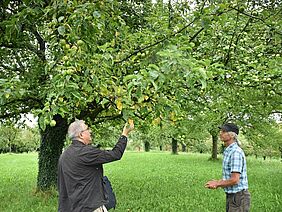The new Marssonina leaf blotch disease has been posing a problem for Europe’s apple producers since 2010. The first spots appear on leaves from June onward and then spread until the leaf has turned yellow throughout and drops off. Trees can lose a considerable amount of foliage in this way, negatively affecting their yields. Until recently, little was known about the disease and how to combat it. FiBL therefore carried out a research project to investigate the fungal pathogen’s biology and ways and means of protecting apple trees from this disease.
Pathogen shows little mutation to date
One bit of good news - at least for the time being - comes from studies on the pathogen Diplocarpon coronariae (formerly Diplocarpon mali): “Genetically the population is rather homogenous throughout Europe, as is typical for a newly introduced organism,” says Thomas Oberhänsli, molecular biologist at FiBL’s Crop Protection – Phytopathology group. “At the moment, the prospects are still good at combating the fungus by using robust apple cultivars.” But it is only a matter of time before the fungus changes
genetically and overcomes existing resistances. Certain modern cultivars such as Ladina, Discovery and Galant or the cider varieties Blauacher, Bohnapfel and Tobiässler are still somewhat resistant to Marssonina. It is difficult to control the fungus. While in the case of apple scab mulching or the removal of fallen leaves from the orchard in the autumn reduces infestation in the following year, this does not appear to be the case for Marssonina leaf blotch. However, the trials have shown that the frequency of treatment has a clear impact.
Bentonite and lime sulphur – the more frequently the better
According to our findings, phytosanitary measures must be taken from May to the end of summer to ensure a satisfactory level of protection. In severely affected orchards with susceptible cultivars, treatments with both preventive agents such as the bentonite product MycoSin and curative agents such as lime sulphur are required. The simulation model RIMpro Marssonina is very helpful in determining the correct times for targeted applications. Studies involving spore traps have shown that the model can very precisely predict periods of infection.




